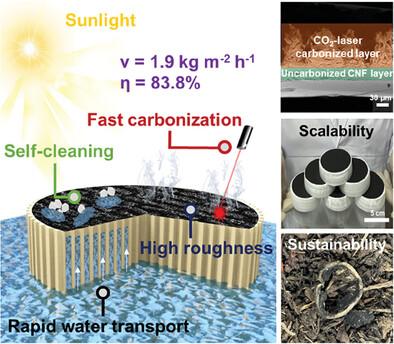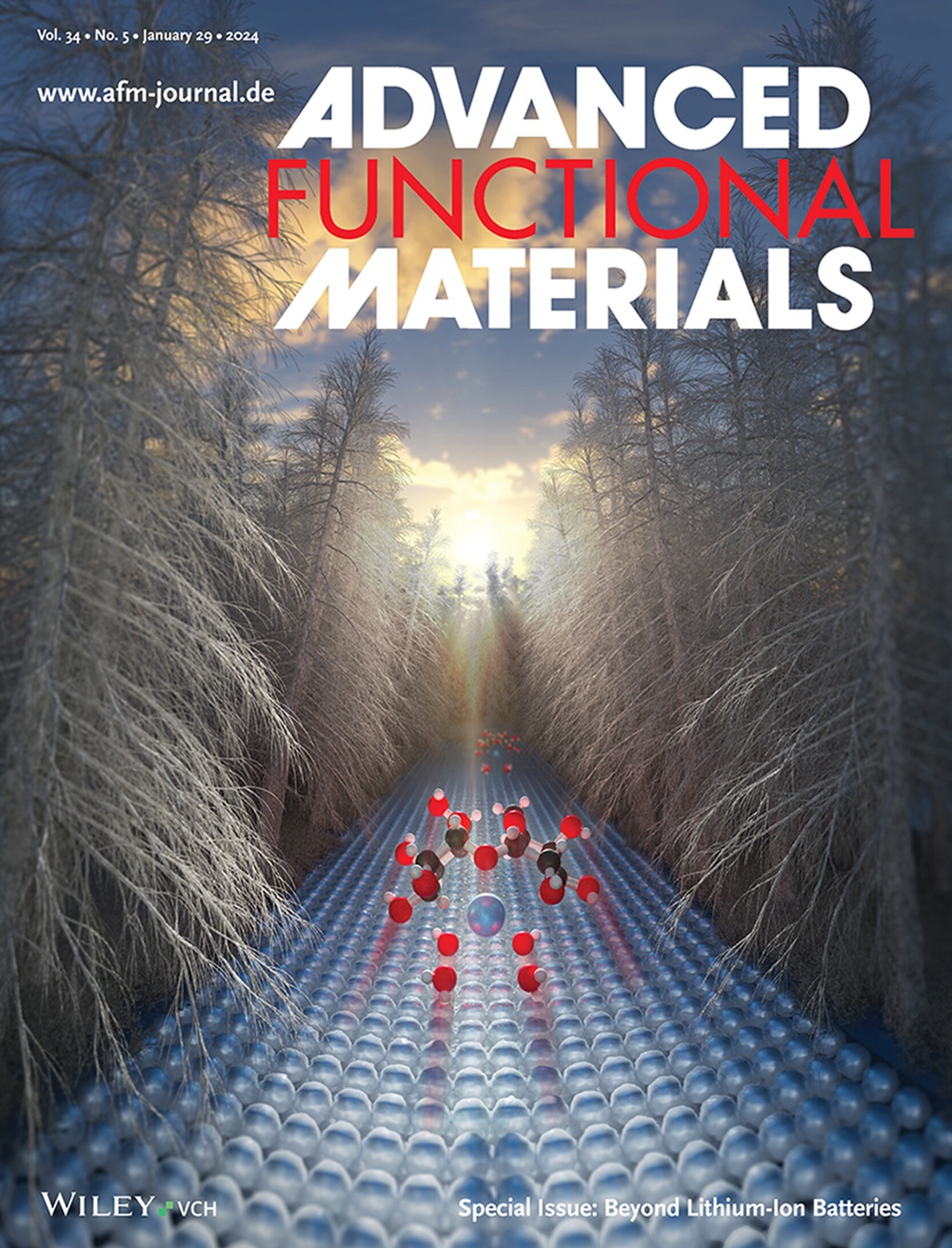基于纳米纤维素的界面太阳能蒸发器:集成可持续材料和微/纳米结构,实现太阳能海水淡化
IF 18.5
1区 材料科学
Q1 CHEMISTRY, MULTIDISCIPLINARY
引用次数: 0
摘要
最近,通过太阳能界面蒸发技术收集清洁水源已成为解决全球水资源短缺问题的一种策略。在这项研究中,利用激光诱导的二氧化碳快速碳化和简便的铸冰技术,构建了一种纤维素基太阳能蒸发器,该蒸发器具有多层微/纳米混合结构(即激光诱导碳(LC)纳米结构和纤维素气凝胶(CA)纳米/微结构)。LC 具有光吸收/光热纳米多孔碳结构,具有高光吸收性和多重光散射性。此外,CA 具有大量纳米孔和单向微通道,可通过毛细作用促进水的快速传输。这种混合 LC/CA 微/纳米结构能够快速产生水蒸气,平均水蒸发率 (ν) 为 1.62 kg m-2 h-1,蒸发效率 (η) 为 66.6%。为了进一步提高蒸发性能,在 LC/CA 蒸发器的侧面涂上了一层聚二甲基硅氧烷 (PDMS),以增加其在模拟水中的漂浮性;涂有 PDMS 的 LC/CA 蒸发器(LC/CA/PDMS)的 ν 和 η 分别增加到 1.9 kg m-2 h-1 和 83.8%。此外,LC/CA/PDMS 蒸发器在模拟海水中的 ν 值高达 1.68 kg m-2 h-1,这源于其出色的自清洁能力,可有效防止盐分积累。此外,太阳能蒸发器还具有可扩展性和可生物降解性。本文章由计算机程序翻译,如有差异,请以英文原文为准。

Nanocellulose-Based Interfacial Solar Evaporator: Integrating Sustainable Materials and Micro-/Nano-Architectures for Solar Desalination
Clean-water harvesting through solar interfacial evaporation technology has recently emerged as a strategy for resolving global water scarcity. In this study, rapid carbon-dioxide-laser-induced carbonization and facile ice-templating is employed to construct a cellulose-based solar evaporator bearing a hybrid multi-layer micro-/nano-architecture (i.e., a laser-induced carbon (LC) nanostructure and a cellulose aerogel (CA) nano/microstructure). The LC exhibits a light-absorbing/photothermal nanoporous carbon structure that offers high light absorption and multiple light scattering. Additionally, the CA exhibits numerous nanopores and unidirectional microchannels that facilitate rapid water transport via capillary action. This hybrid LC/CA micro-/nano-architecture enabled rapid vapor generation with an average water evaporation rate (ν) of 1.62 kg m−2 h−1 and an evaporation efficiency (η) of 66.6%. To further enhance the evaporation performance, a polydimethylsiloxane (PDMS) layer is coated onto the side of the LC/CA evaporator to increase its floatability in the simulated water; ν and η of the PDMS-coated LC/CA evaporator (LC/CA/PDMS) increased to 1.9 kg m−2 h−1 and 83.8%, respectively. Additionally, the LC/CA/PDMS evaporator exhibited a high ν value of 1.68 kg m−2 h−1 in simulated seawater, originating from excellent resistance to salt accumulation via its self-cleaning ability. Furthermore, the solar evaporator exhibited scalability for fabrication as well as biodegradable properties.
求助全文
通过发布文献求助,成功后即可免费获取论文全文。
去求助
来源期刊

Advanced Functional Materials
工程技术-材料科学:综合
CiteScore
29.50
自引率
4.20%
发文量
2086
审稿时长
2.1 months
期刊介绍:
Firmly established as a top-tier materials science journal, Advanced Functional Materials reports breakthrough research in all aspects of materials science, including nanotechnology, chemistry, physics, and biology every week.
Advanced Functional Materials is known for its rapid and fair peer review, quality content, and high impact, making it the first choice of the international materials science community.
 求助内容:
求助内容: 应助结果提醒方式:
应助结果提醒方式:


